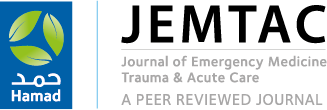-
oa Moving towards an interactive teaching and learning curriculum - Analysis of Qatar's Emergency Medicine Residency Training Program
- Source: Journal of Emergency Medicine, Trauma and Acute Care, Volume 2016, Issue 2 - International Conference in Emergency Medicine and Public Health-Qatar Proceedings, Oct 2016, 46
-
- 09 October 2016
Abstract
Background: The Emergency Medicine Residency Training Program (EMRTP) conducts weekly didactic teaching activities to deliver the curriculum for the Arab Board of Emergency Medicine. Traditional teaching methods often serve to deliver content to the learner passively, while an interactive model engages the resident, and aligns with principles of adult learning. With the accreditation of the EMRTP by the Accreditation Council for Graduate Medical Education - International (ACGME-I), the mode of teaching has also been modified to a more interactive model.
Methods: We analysed the EMRTP annual academic planner for 2015–2016 along with the format of teaching and broadly classified the topics and content into traditional vs interactive modes of delivery.
Results: The results showed that in 2012–2013, 75% of the content was through lectures but in 2015–2016 this had diminished to 21%, with the remaining 79% being delivered through various interactive means such as multidisciplinary grand rounds, joint conferences, morbidity & mortality meetings, journal clubs, oral board simulations, objective structured clinical examination (OSCE) slide presentations and faculty led clinical skills workshops.
Conclusion: The analysis showed an impressive reversal from a traditional to an interactive educational format with clear demonstration of adult learning principles.


